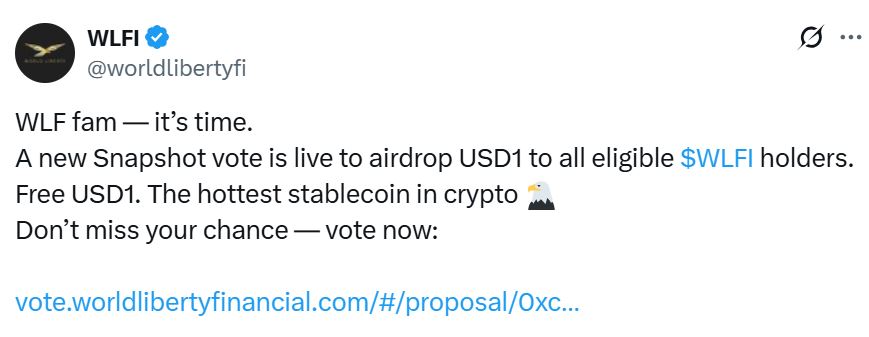World Liberty Financial (WLFI), a crypto platform with ties to the Trump family, is planning to airdrop a small amount of its USD1 stablecoin to existing WLFI token holders. This initiative aims to test the platform’s airdrop mechanism and reward early supporters. The proposal, currently with over 99% approval in the WLFI governance forum, outlines the distribution of USD1 to eligible wallets.
Key Takeaways:
- WLFI proposes airdropping USD1 to WLFI token holders.
- The initiative is primarily to test the airdrop mechanism.
- Over 99% of votes are in favor of the proposal.
- The airdrop amount is a token of appreciation to early supporters.
Why is WLFI doing this?
According to the proposal, testing the airdrop mechanism in a live environment is crucial to ensuring the smart contract’s functionality and readiness. This approach allows WLFI to validate the technical aspects of its airdrop system while simultaneously thanking its early supporters by introducing them to USD1.
“Testing the airdrop mechanism in a live setting is a necessary step to ensure smart contract functionality and readiness. This distribution also serves as a meaningful way to thank our earliest supporters and introduce them to USD1,” the proposal states.

Airdrop Details:
While the exact amount of USD1 to be airdropped is still under consideration, it will be determined based on the number of eligible wallets and the allocated budget. The date of the airdrop is also pending, and WLFI reserves the right to modify or terminate the test airdrop at any time.
The vote for the airdrop is scheduled to conclude on May 14. Current results show overwhelming support, with 2.6 billion tokens (99.97%) voting in favor, and approximately 901,000 votes (0.03%) against.

WLFI and USD1: A Quick Recap
WLFI launched its USD1 stablecoin in early March. Since its inception in September, the platform has conducted two public token sales, raising a total of $550 million from 85,000 registered holders.
The Broader Stablecoin Landscape: Challenges to USD Dominance
The market capitalization of USD-denominated stablecoins surpassed $230 billion in April, marking a 54% increase since last year. Tether (USDT) and USDC dominate this market, holding approximately 90% of the total share. However, the dominance of USD-backed stablecoins faces challenges from other countries exploring their own currency-backed stablecoins.
Alternatives to USD Stablecoins:
- Abu Dhabi: Three major Abu Dhabi institutions are collaborating to launch a dirham-pegged stablecoin.
- Russia: A Russian finance ministry official proposed developing a national stablecoin after sanctions impacted wallets associated with a Russian exchange and Tether.
What are Stablecoins?
Stablecoins are cryptocurrencies designed to maintain a stable value relative to a reference asset, such as the US dollar or gold. This stability makes them useful for trading, lending, and payments within the cryptocurrency ecosystem. They achieve stability through various mechanisms, including:
- Fiat-backed: Backed by reserves of fiat currency (like USD) held in custody.
- Crypto-backed: Backed by other cryptocurrencies, often with over-collateralization to account for price volatility.
- Algorithmic: Rely on algorithms to adjust the supply of the stablecoin to maintain its peg.
Benefits of Stablecoins:
- Price Stability: Reduces volatility compared to other cryptocurrencies.
- Faster Transactions: Offers faster and cheaper transactions than traditional banking systems.
- Global Accessibility: Enables cross-border payments without the need for traditional intermediaries.
- Decentralization: Provides a degree of decentralization compared to traditional financial systems.
Risks of Stablecoins:
- Regulatory Uncertainty: The regulatory landscape for stablecoins is still evolving.
- Centralization Risks: Fiat-backed stablecoins rely on centralized entities to manage reserves.
- Algorithmic Risks: Algorithmic stablecoins can be vulnerable to de-pegging events.
- Custody Risks: There are risks associated with the custody of underlying assets.
The Future of Stablecoins:
The stablecoin market is expected to continue growing, driven by the increasing adoption of cryptocurrencies and the demand for stable digital assets. Innovations in stablecoin technology, such as improved pegging mechanisms and enhanced regulatory oversight, are likely to shape the future of the market.
Conclusion:
WLFI’s airdrop represents a small step in the development of its USD1 stablecoin. It’s also indicative of a broader trend towards stablecoins backed by currencies other than the US dollar. The evolution of stablecoins will undoubtedly play a crucial role in shaping the future of digital finance.